Easter Bread is traditional in many European countries including Russia, Greece, Poland and more. Usually a slightly sweet bread filled with dried or candied fruit, it can be glazed or not.
These are easy to make rich in butter and eggs and area the focus of the breakfast or brunch table. This is my version of a European Easter Bread.
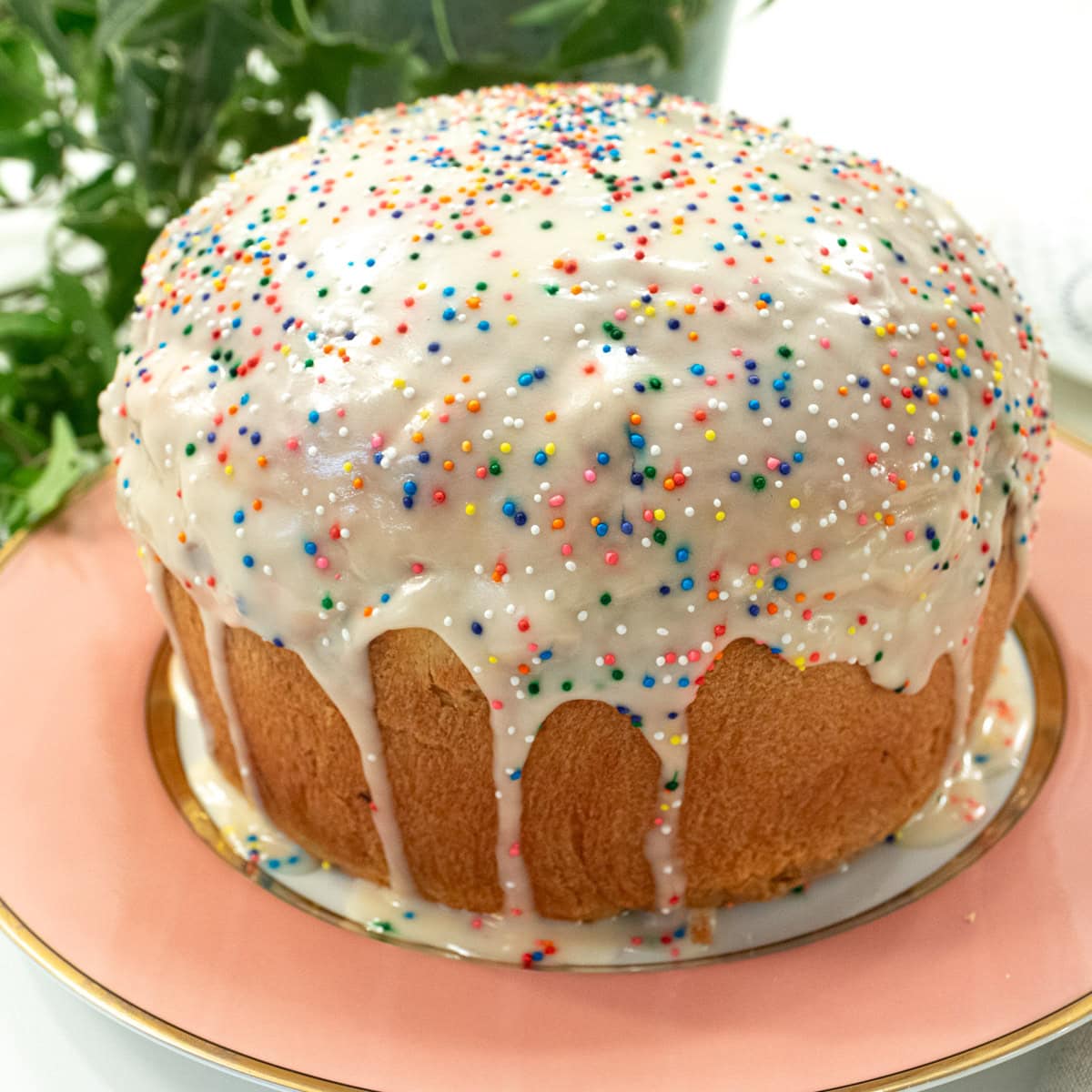
Usually made in tall molds, I did not have one but I did have a French Charlotte Mold which I took when we left our house - and am very glad I did. Any 8 to 9 cup pan will do such as a bundt pan, angel food pan, or deep pan - the shape isn't as important as what is in it.
The dried fruit can be anything you wish. I used raisins, dried cranberries and dried apricots.
Jump to:
Why You'll Want to Make this Easter Bread
- It goes together really fast.
- It just might become an Easter tradition in your house.
- Easter Bread is a great center piece - it's as delicious as it is beautiful.
- The bread can be made ahead.
- It has minimal ingredients and maximum flavor.
Variations
Arlene, one of my readers was thoughtful enough to send this to me and I want to share it with you. Here are Easter breads from different parts of the world. Thank you Arlene.
1. for Paska (Easter Bread from the Canadian Prairie regions), omit the fruit, but add the juices and zests of a lemon and an orange
2. for Italian Columbo di Pasqua, go plain, or add candied fruit, or chocolate chips, zest and juice of lemons and oranges, and top the loaf with almonds
3. for Portuguese Folar de Pascoa -- add a little anise seed
The variations are endless, but this recipe will provide the foundation for your creativity in the kitchen.
Recipe Ingredients
Bread Ingredients
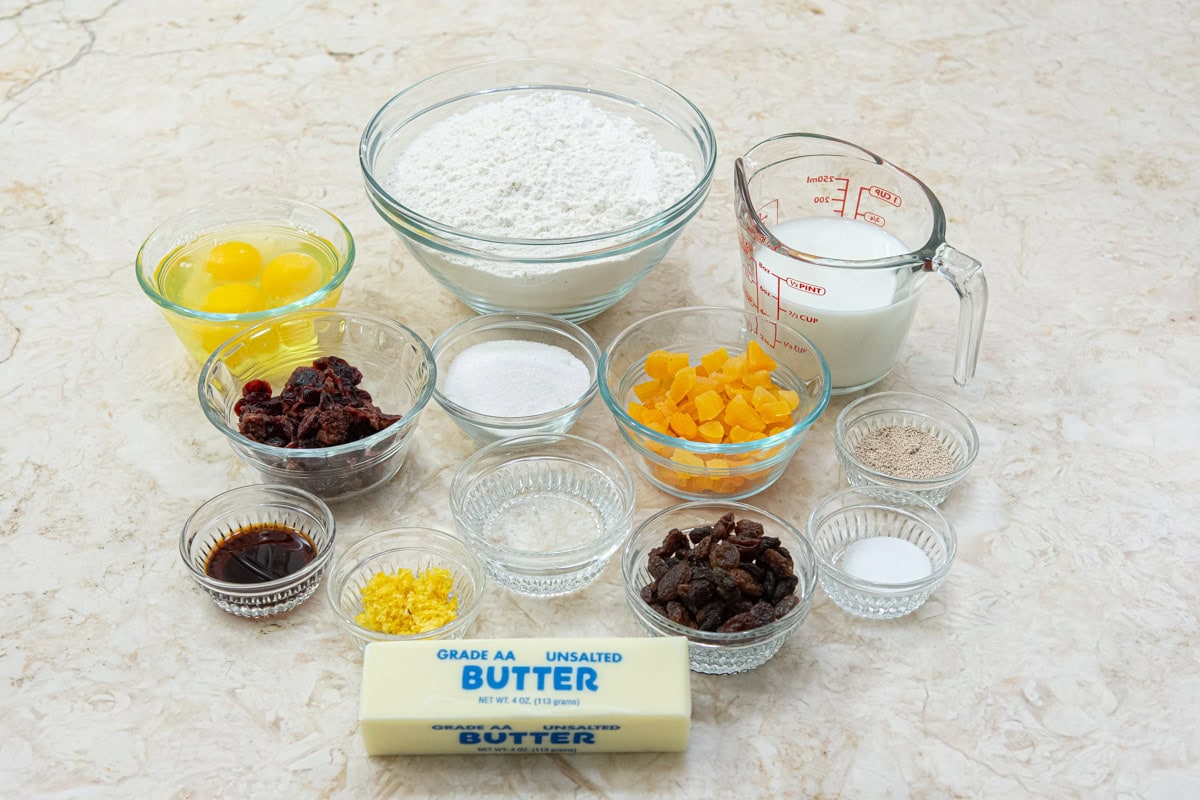
The Easter Bread contains, unsalted butter, yeast, milk, granulate sugar, salt, eggs, vanilla, lemon zest, bread flur, raisins, dried cranberries, dried apricots.
Glaze Ingredients
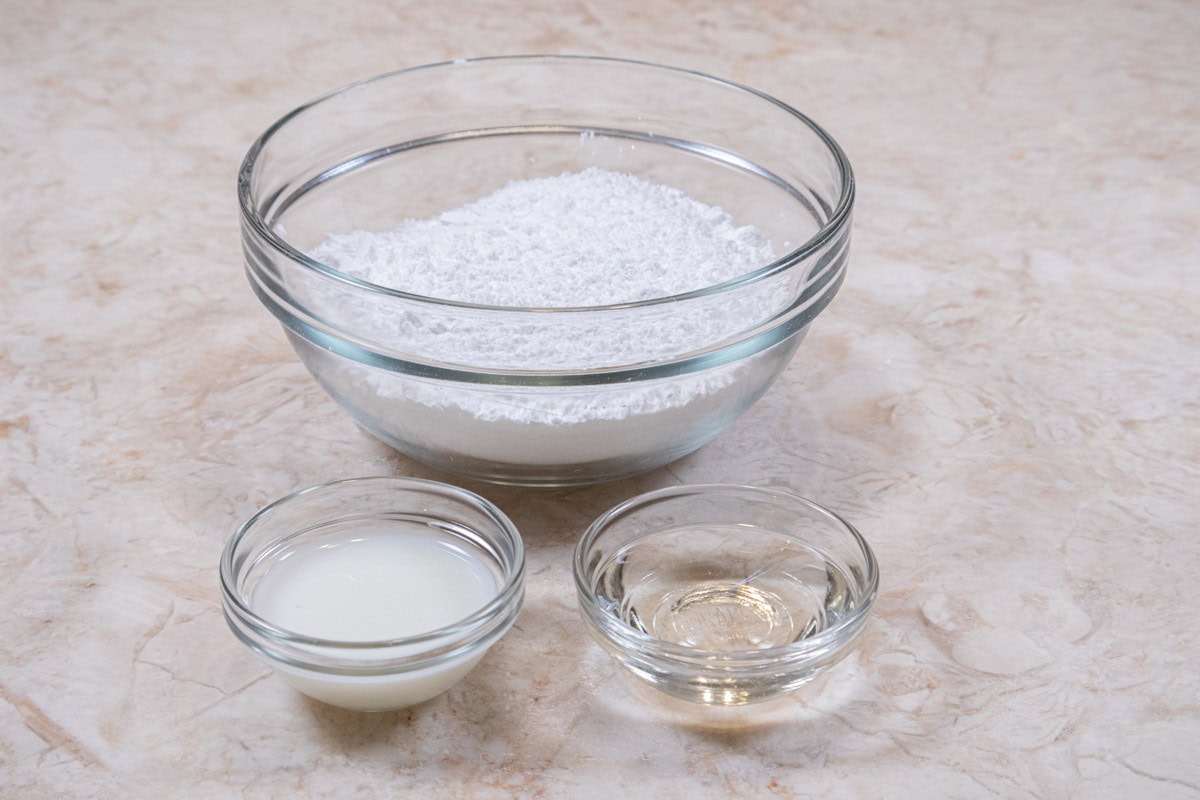
Glaze ingredients are powedered sugar, milk and corn syrup
Important ingredients
- Unsalted butter
- Whole or 2% milk can be used.
- Any combination of dried or candied fruit can be used.
- I use instant yeast, but active dry yeast can be used also.
- For the Glaze milk and corn syrup is used to give the bread a shiny finish that lasts and won't become dull.
Be sure to see the recipe card below for the full ingredients & instructions.
Step by Step Instructions
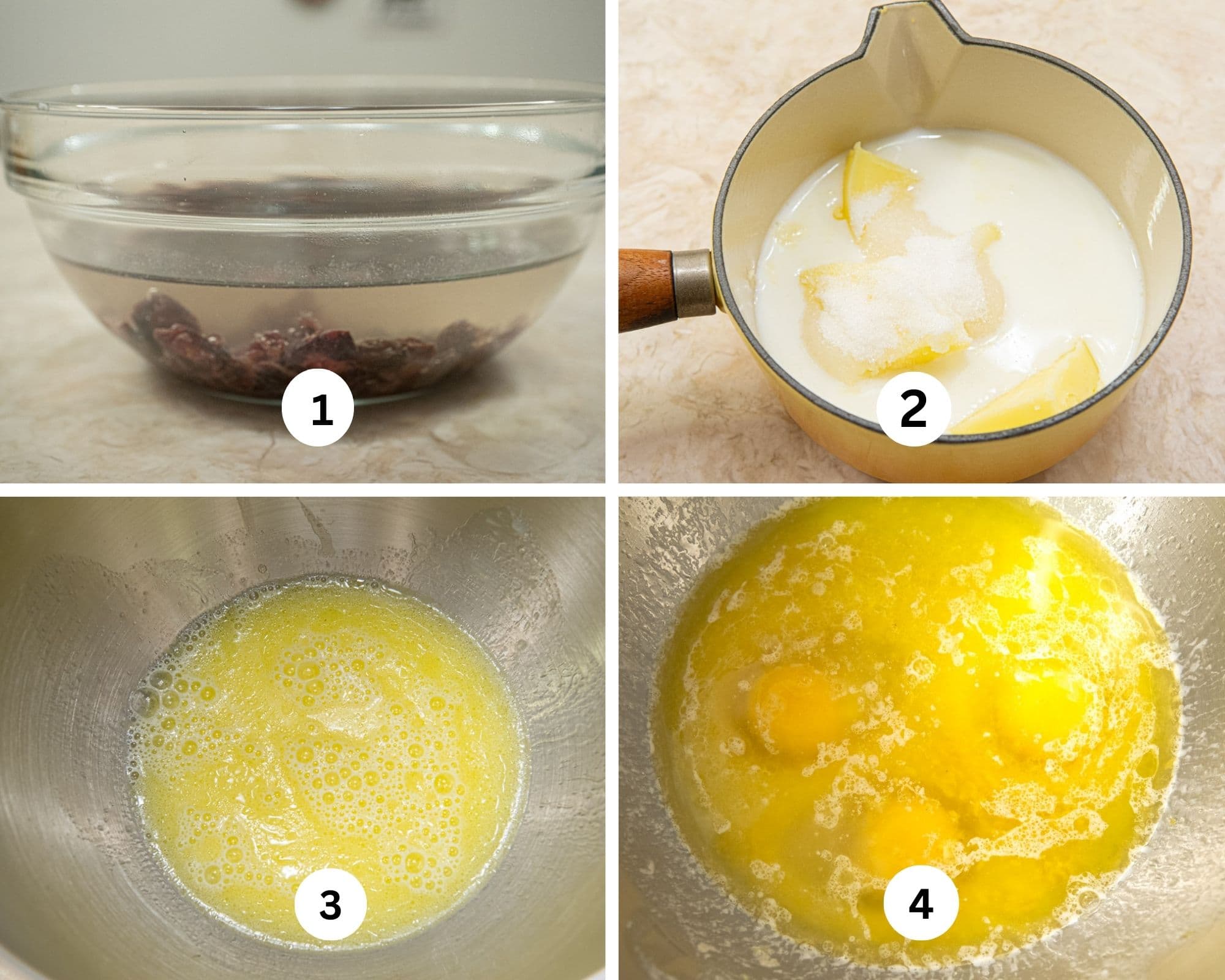
Step 1. Soak the raisins and cranberries in really hot water while the rest of the recipe is prepared. Step 2. Place the milk, sugar and butter in a small saucepan. Heat to melt the butter and cool to lukewarm. Step 3. Pour the liquid into a mixing bowl. Step 4. Add the eggs, vanilla, yeast, and lemon zest.
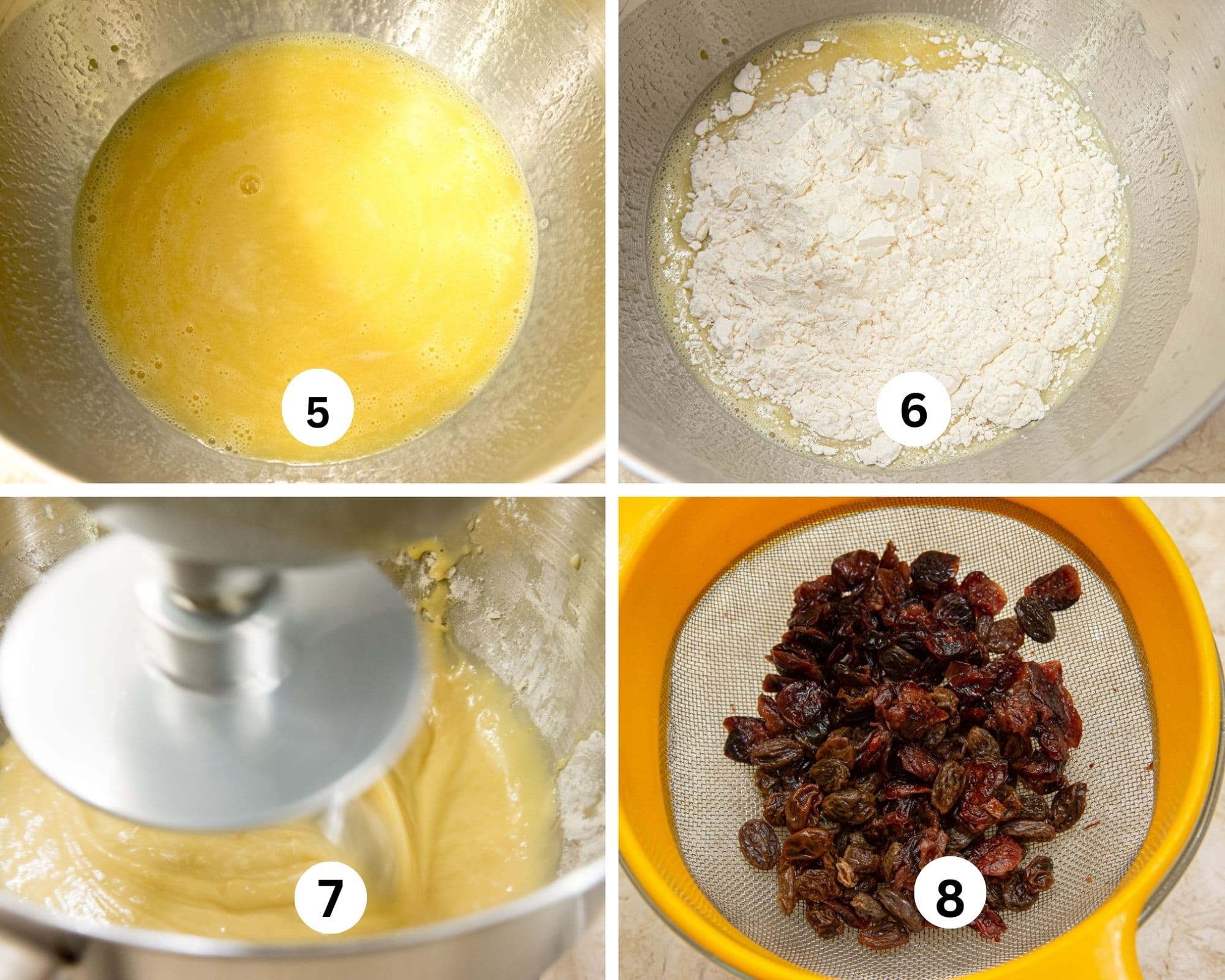
Step 5. Whisk together the egg mixture in the mixing bowl. Step 6. Add half the flour Step 7. Beat on medium until combined. Step 8. Drain the raisins then squeeze all the water from them.
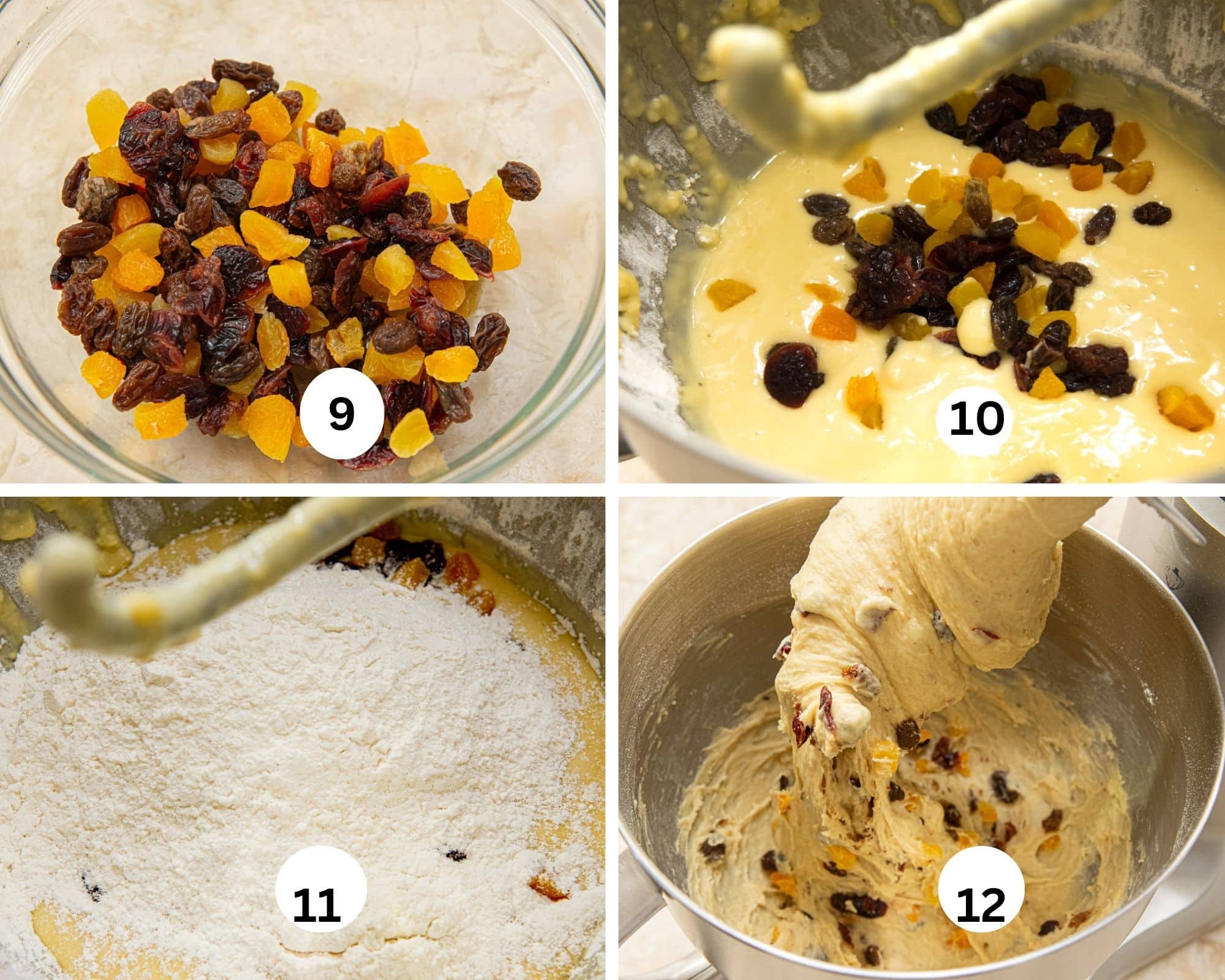
Step 9. Add the raisins to the cranberries and apricots. Step 10. Pour the fruit into the mixing bowl. Step 11. Add the remainder of the flour. Step 12. Add the fruit to the mixing bowl and beat on medium until it is mixed in.
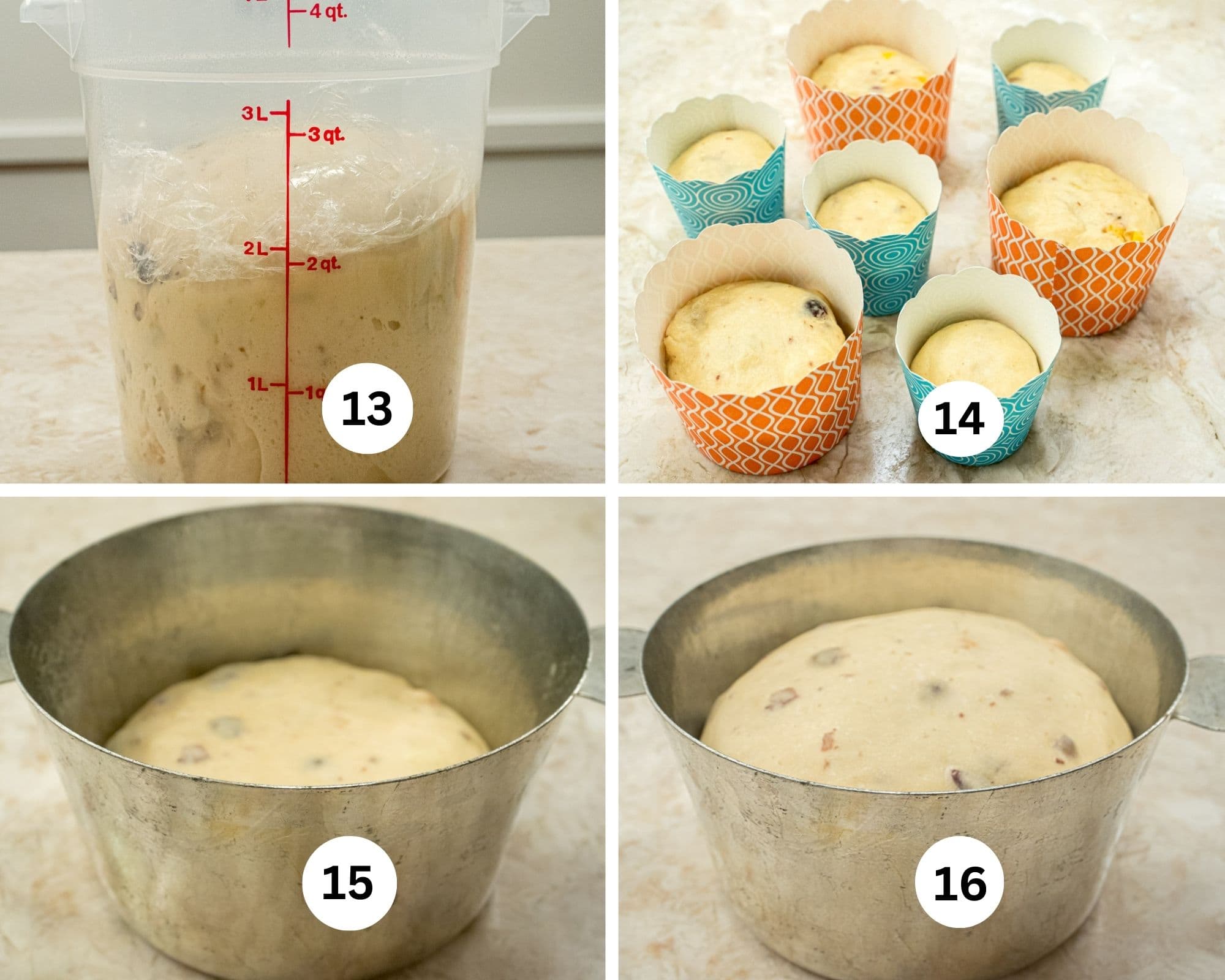
Step 13. Place the dough in a sparyed container at least 3 times the size of the dough, cover it with film and place the top on. Mark the time on it and allow it to rise until doubled in bulk, about 2 hours. At this point it can be shaped immediately or refrigerated up to 3 days before shaping and baking. Step. 14. The dough is shaped into balls of different sizes to fit into bake-proof cups. Step 15. The dough is formed into a ball and placed in a container that has been sprayed with a non-stick baking release. Step 16. The dough is risen and ready for the oven. After baking, it is cooled and the glaze is applied.
Recipe FAQS
Before instant yeast, active dry yeast was dissolved in liqiud to soften it so it would become one with the rest of the ingredients. While it is technically not necessary to dissolve instant yeast, I still add it to liquid to give it a good start.
Not always, but it is often specified because it is stronger than all-purpose flour, it rises higher when baked.
It depends upon how dry it is. Generally, raisins are always soaked but other dried fruit such as dried cranberries and dried cherries can be or not, depending upon their moisture content.
Expert Tips
- Use Bread flour to get the highest rise and lightest texture.
- As a rich dough (one that has butter, eggs and sugar), this can be a slow riser. If it is, put in an oven with the light turned on. Place an instant thermometer in the oven with the bread. Check it in about 45 to 60 minutes to make sure it is not too hot. It should not be hotter than about 80° to 85°F. If it is, prop the door open with a wood spoon.
- Any 8 to 9 cup bake-proof container can be used, especially if it is tall. If the pan is shorter, like a bundt pan, the baking time may have to be reduced.
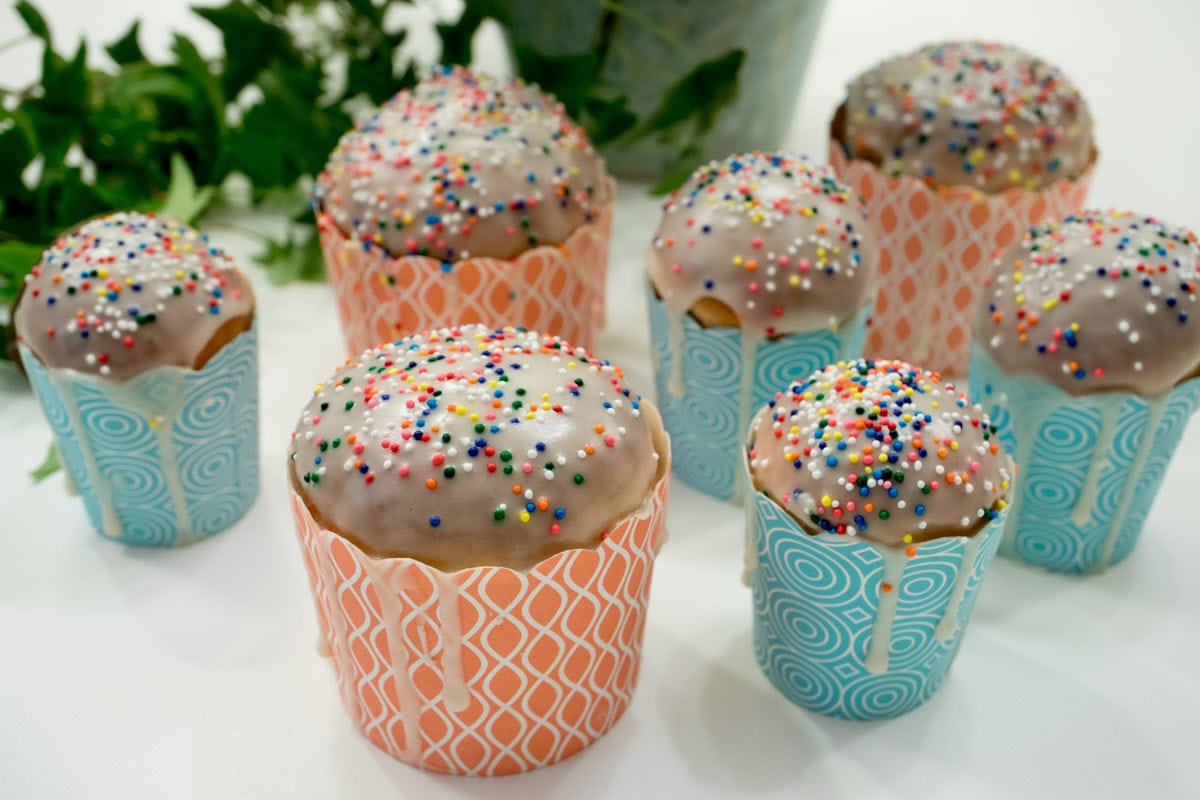
Other Special Breads
Love this Easter Bread? It would be hugely helpful and so appreciated it if you would take a moment to leave a rating. Thank you.
My Easter Bread
Ingredients
Easter Bread
- 1 cup milk*
- ½ cup unsalted butter (114 grams or 1 stick)
- ½ cup granulated sugar (100 grams)
- ½ teaspoon salt
- 3 large eggs
- 1 teaspoon vanilla
- Zest from 1 medium lemon
- 2 ¼ teaspoons instant yeast
- 4 cups bread flour (560 grams)
- 1 ½ cups dried or candied fruit**
- *if using active dry yeast, dissolve it in ¼ cup water and use ¾ cup milk
- **I used ½ cup raisins, ½ cup dried cranberries and ½ cup dried apricots
Glaze
- 1 ½ cup powdered sugar (200 grams)
- 1 tablespoon corn syrup
- 3 to 4 tablespoons milk
- Multi colored nonpareils as needed.
Instructions
Easter Bread
- If using dried fruit such as raisins, dried cranberries, dried cherries soaked in them in really hot water while preparing the rest of the recipe.
- If using active dry yeast, add it to ¼ cup warm water and reduce the milk to ¾ cup adding it where called.
- If using instant yeast, use 1 cup of milk.
- Heat the milk, butter, sugar and salt in a small saucepan until the butter is melted. Cool to lukewarm and pour it into a mixing bowl fitted with a douogh hook. .
- Whisk the yeast, eggs, vanilla and lemon zest into the milk mixture.
- Add half the flour and beat on medium until completely combined and smooth.
- Drain the soaked fruit very well and squeeze out any water. Mix it with the other fruit. Add the fruit to the batter along with the remaining flour. Beat until smooth; beat for 3 minutes more.
- Spray a container at least 3 times as big as the bread. Spray it with a non-stick baking release and put the dough in. Cover with plastic wrap and cover the container, marking the time on it. Allow it to rise until at least doubled,
- This is a rich dough and, as such, can be a slow riser if the room is cool. If so, place the container in the oven with the light on and an instant thermometer. Check in about 45 to 60 minutes to make sure the temperature is no higher than 85*F. If it is, prop the oven door open with a wooden spoon.
- At this point the dough can be worked right away or it can be refrigerated for up to 3 days.
- When ready to shape, spray your pan well. Shape the dough into a ball and place it in the pan, pressing it down to flatten it. The dough should come up about half way or a bit more. Cover and let it rise for about 1 to ½ hours or until it is light and risen.
- For the small individual Easter Bread I used 40 grams for a 2 ounce container and 90 grams for the 5 ounce container, Be sure to spray the containers. Cover and let rise for about 1 ½ hours.
- Preheat the oven to 350°F. Bake the large Easter Bread for 35 to 40 minutes until deeply browned. Cover the top loosely with foil if it browns too quickly. Bake the smaller breads about 20 to 25 minutes. Cool before glazing.
To Glaze
- Mix the ingredients together with a spoon A whisk incorporates too many air bubbles. You want this to run down the sides of the bread, but still be decently thick on top. Add milk sparingly if needed.
- To finish the large bread, pour the glaze in the middle and push it over the edge so it runs down the sides a bit. Sprinkle with the nonpareils immediately,
- Do the same, in smaller amounts for the small ones. Springle with the nonpareils immediately.
- Allow the glaze to dry.


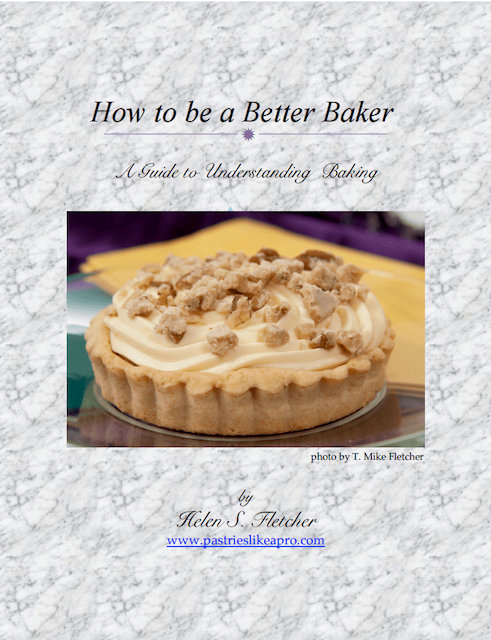
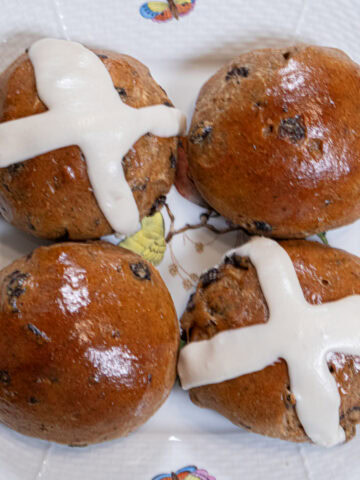
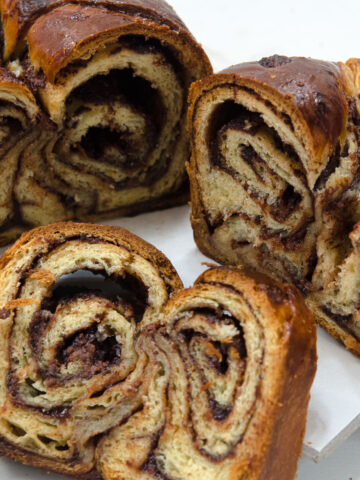
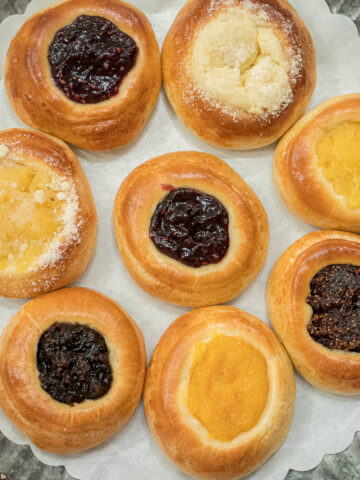
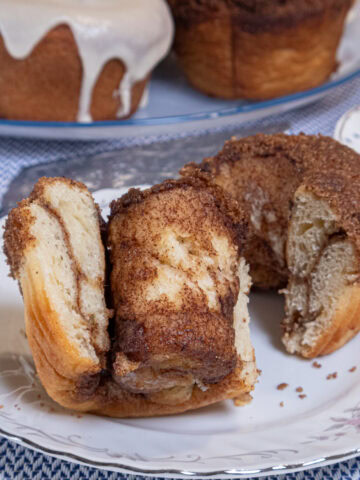
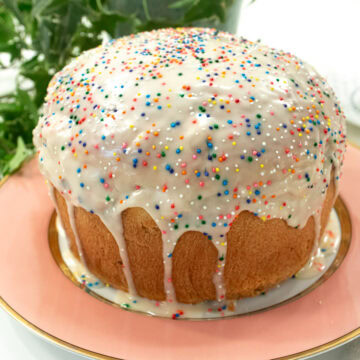

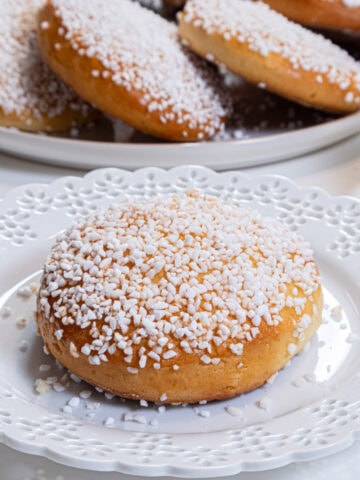
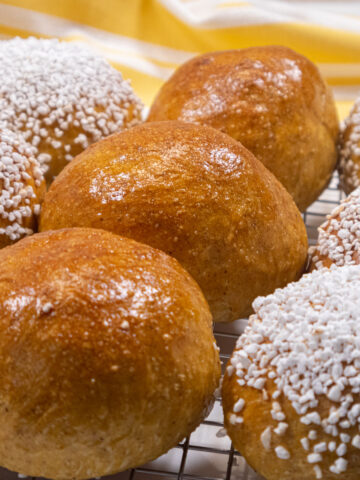
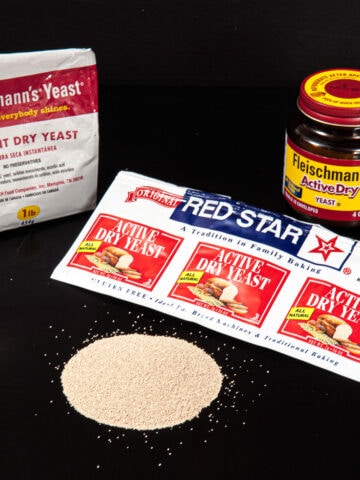
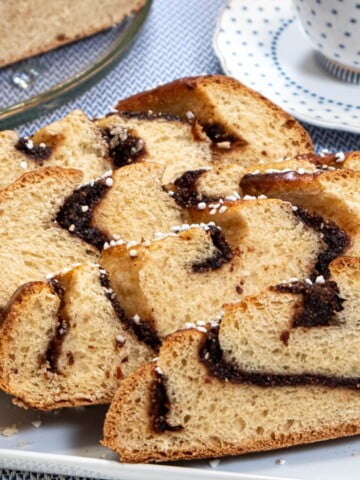
Anne Dolce says
Hi:
Recipe looks fabulous. My only grievance. Would love to see a picture of the inside of the bread. Thanks for your great site.
Helen S Fletcher says
Hi Anne - not sure how to respond. Photographing the recipes step by stepIt takes me at least a day to take the photos, plus at least a day to go through them, work up the collages, take the final picture which usually takes a couple of hours and then write the text. I have a minimum of 3 days per post including shopping, prepping the recipe, making it, baking and/or decorating. I'm sorry I missed a picture. Thanks for the kind words. I love what I do and love more sharing it. I'm not trying to be snarky, I just don't think people understand what goes into a blog like mine.
Anne Wallace says
Hello there,
I love your blog so much. I think years ago Sally at Bewitchin’ Kitchen sang your praises in a post and been following ever since, plus own your latest book
Quick question: I looked online for 5oz Easter bread paper liners. I only found large cupcake liners that size. So I bought some pretty liners with folk patterns from Eastern Europe instead but the size is 12 ounces. I was wondering how many Easter breads I could make using this alternative size?
Love all the variations I see were added thanks to a kind reader’s suggestions. I am leaning now towards making three flavors.
Cheers,
Anne
Helen S Fletcher says
Hi Anne, I would imagine if I used 5 ounce and you have 12 ounce you would get half as many as the 5 ounce. Thanks for the kind words.
teresa cole says
I am having an event on Easter and I will make this bread as a give-away prize. Thank you so much!
Helen S Fletcher says
Hi Teresa, what a fantastic idea. I am so honored to be part of your event.
Judith Willson says
Dear Helen,
I have been trying to get in touch with you many times by email as I want to buy a Breville Chef Mixmaster from you, but so far have not been able to get through to you. You mentioned if one wanted to buy this machine to buy it from you rather than other outlets. Your demonstration of this machine was so good and informative that I now need to purchase one. Would you please reply to me at [email protected]
Helen S Fletcher says
Hello Judith - I just emailed you with information on buying the Breville. You cannot buy through me. You have to click on the Buy button in the post and it will take you to Breville where you can purchase the machine. They then pay me an affiliate commission. Hope this helps.
Arlene says
This recipe for Easter Bread is excellent and easy (thanks to the detailed information and photos in the post). It also serves as a basic sweet dough which can inspire other cultural variations:
1. for Paska (Easter Bread from the Canadian Prairie regions), omit the fruit, but add the juices and zests of a lemon and an orange
2. for Italian Columbo di Pasqua, go plain, or add candied fruit, or chocolate chips, zest and juice of lemons and oranges, and top the loaf with almonds
3. for Portuguese Folar de Pascoa -- add a little anise seed
The variations are endless, but this recipe will provide the foundation for your creativity in the kitchen.
Helen S Fletcher says
Thanks so much Arlene - I'll add these as variations to the basic bread. I love it when readers add information to the posts. It helps us all get smarter.